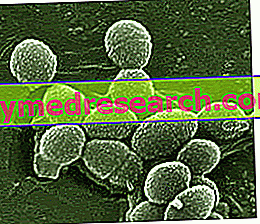Definition
The term "dermatitis" refers in a generic way to a set of skin pathologies, characterized above all by inflammatory phenomena.
There are different types of dermatitis: seborrheic, atopic (also known as atopic eczema or eczematous dermatitis), allergic (otherwise called contact dermatitis), herpetiformis (or Duhring dermatitis), perioral, solar polymorphous and diaper.
Causes
The causes of the disease are different for each type of dermatitis.
The factors that favor the onset of the disease can be infections (as in the case of seborrheic dermatitis), contact with irritated substances or with allergens (as in the case of allergic dermatitis), genetic predisposition (as in the case of atopic dermatitis and of dermatitis herpetiformis) or exposure to sunlight (as in the case of polymorphic solar dermatitis).
The development of diaper dermatitis, on the other hand, is favored above all by the continuous rubbing of the diaper on the skin and the prolonged contact with urine and faeces.
The cause of perioral dermatitis, on the other hand, is still a matter of debate. Some argue that it may be a complication of rosacea (another skin disorder). Still others argue that topical application of corticosteroid drugs and the use of dental products containing fluoride play an important role in the development of the disease.
Additional factors that can contribute to the development of different types of dermatitis are stress, food shortages or excesses, food intolerances (as in the case of herpetiform dermatitis) and environmental factors.
Symptoms
Of course, the symptoms are also different depending on the type of dermatitis.
Some of these symptoms, however, are found in all forms of dermatitis and consist of: redness, itching and / or pain, skin swelling and the presence of lesions or blisters.
The most specific symptoms, however, are:
- Seborrheic dermatitis: oily dandruff of the scalp, loss of greasy scales in areas rich in sebaceous glands.
- Atopic dermatitis: dry and reddened skin accompanied by itching, scaling and skin cracks.
- Allergic dermatitis: itching, inflammation, swelling, scaling and irritation. Sometimes, vesicles are also present.
- Herpetiform dermatitis: irritation and inflammation with the presence of itchy eruptions.
- Perioral dermatitis: formation of erythematous papules at the nasolabial folds and around the mouth.
- Polymorphic solar dermatitis: erythematous and itchy papules, vesicles, pustules or plaques in areas most exposed to sunlight.
- Diaper rash: skin rash, redness, swelling and skin pain.
Diet
Information on Dermatitis - Drugs to Treat Dermatitis is not intended to replace the direct relationship between health professional and patient. Always consult your doctor and / or specialist before taking Dermatitis - Drugs to Treat Dermatitis.
drugs
The treatment of dermatitis varies according to the form of which one suffers.
If dermatitis is caused by an external agent (such as irritants, allergens, sunlight, etc.), the first thing to do is to avoid contact and / or exposure to the agent.
Moreover, very important factors for controlling the symptoms of dermatitis are the diet - which must be balanced and rich in vitamins, fundamental for the health of the skin - and the careful personal hygiene. Furthermore, after daily cleansing, even the application of emollient and moisturizing products can be useful to give relief and to soften the superficial layers of the skin.

Seborrheic dermatitis
Seborrheic dermatitis is caused by a fungal infection sustained by Malassezia furfur . The treatment of this form of dermatitis involves the use of detergent formulations based on salicylic acid, zinc, selenium and coal tar .
In cases of more severe seborrheic dermatitis, on the other hand, the doctor may prescribe pharmaceutical preparations for topical use based on corticosteroids or antifungal agents.
Ketoconazole (Triatop ®, Nizoral ®) are among the most widely used antifungals. It is available as a gel, foam, cream or shampoo. When used in the form of gel, it is recommended to apply the product directly to the affected area once a day, for a period of two weeks.
For more detailed information on the treatment of seborrheic dermatitis, see the article on "Medicines for the Treatment of Seborrheic Dermatitis".
Atopic dermatitis (atopic eczema)
Atopic dermatitis is a disease caused by several factors, among which the genetic predisposition and the environmental factors that surround the individuals that are affected stand out.
The treatment of atopic dermatitis involves the application of emollients and pharmaceutical preparations for cutaneous use based on corticosteroids. Among the steroidal anti-inflammatories that can be used for the treatment of atopic dermatitis, we recall:
- Hydrocortisone (Locoidon ®, Dermirit ®): it is recommended to apply the product for dermal use based on hydrocortisone directly on the affected area, once or twice a day, according to the doctor's prescription.
- Dexamethasone (Dermadex ®): when using dexamethasone cream, it is recommended to apply two or three applications a day directly on the affected area. The duration of treatment must be established by the doctor. In the most serious cases of atopic dermatitis, dexamethasone can also be used systemically (Decadron ®, Soldesam ®).
If the itching caused by atopic dermatitis is particularly annoying, the doctor may decide to also administer oral antihistamine drugs.
Furthermore, in the treatment of atopic dermatitis, controlled exposure to UVA and UVB rays may also be useful.
For more information regarding the treatment of atopic dermatitis, see the article already on this site "Eczema treatment drugs".
Allergic dermatitis
This form of dermatitis is caused by an excessive reaction of the immune system, which occurs following contact with certain types of allergens.
Therefore, the individuals who develop allergic dermatitis must, first of all, avoid contact with the allergen, even if this is unfortunately not always possible.
Generally, in case of allergic dermatitis, the doctor prescribes pharmaceutical preparations for cutaneous use based on corticosteroids. The steroidal anti-inflammatories that can be used for the treatment of allergic dermatitis are the same as those that can be used in the treatment of atopic dermatitis (ie, dexamethasone, hydrocortisone, etc.).
Dermatitis herpetiformis (dermatitis of Duhring)
This particular type of dermatitis is directly related to celiac disease. In fact, if a person develops this form of dermatitis, it means that he is also affected by celiac disease. However, the opposite is not true, since a celiac individual does not necessarily develop this skin pathology.
The dermatitis herpetiformis can therefore be considered as the cutaneous manifestation of a food intolerance. It should also be remembered that the development of both celiac disease and herpetiform dermatitis is closely related to the presence of a very precise genetic predisposition.
Given the link with celiac disease, patients who experience dermatitis herpetiformis must absolutely follow a gluten-free diet.
In the event that the change of diet is not sufficient to control the skin disease, then the doctor may decide to prescribe the administration of dapsone (a drug with immunomodulatory action that is also used in the treatment of leprosy). The dose of drug to be administered must be established by the same doctor on an individual basis for each patient.
Perioral dermatitis
The exact cause that triggers the onset of perioral dermatitis has not yet been fully clarified. However, the treatment of this disease involves the interruption of possible corticosteroid-based therapies for topical use and the suspension of the use of dental products containing fluoride.
The drugs commonly used in the treatment of perioral dermatitis are antibiotics given topically or orally. These include:
- Erythromycin (Eryacne ®): erythromycin is a drug belonging to the class of macrolides, which can be used in the treatment of perioral dermatitis in the form of pharmaceutical formulations for cutaneous use.
When using erythromycin based gel, it is recommended to apply the product directly to the affected area twice a day, or according to the doctor's prescription.
- Metronidazole (Rosiced ®, Rozex ®): metronidazole is an antibiotic drug that - in the form of a cream, gel or skin emulsion - is used in the papulopustular manifestations of rosacea, but is also used in the treatment of perioral dermatitis. Generally, it is recommended to apply an adequate amount of product in the areas affected by the disease, once or twice a day, or according to the doctor's judgment.
- Doxycycline (Bassado ®, Miraclin ®): doxycycline is an antibiotic belonging to the tetracycline class. For the treatment of perioral dermatitis, it is usually administered orally. The dose of medication to be taken should be determined by your doctor. Treatment generally lasts 6-8 weeks.
Polymorphic solar dermatitis
Polymorphic solar dermatitis is due to an unusual skin response to ultraviolet radiation exposure. In fact, following this exposure, we witness the release of chemical mediators that trigger skin inflammation, accompanied by itching and the formation of erythematous vesicles or papules.
The treatment of polymorphic solar dermatitis involves moderating sun exposure and - if the doctor considers it necessary - the administration of corticosteroid drugs, so as to control the symptoms, such as itching and other cutaneous manifestations. The steroid anti-inflammatories that can be used to treat this form of dermatitis are similar to those previously described for the treatment of atopic dermatitis.
Diaper dermatitis
If diaper dermatitis is not complicated by any infections, its treatment involves keeping the area clean and dry and applying a zinc oxide paste to treat the skin irritation that has developed.
If, on the other hand, diaper rash is complicated by concomitant infections, then drug treatment is required. In these cases, the doctor may decide to prescribe:
- Corticosteroids, such as hydrocortisone (Locoidon ®, Dermirit ®) for cutaneous use. Its use, however, must be limited to cases in which the irritation is very serious and does not improve with alternative treatments. The exact dosage of hydrocortisone must be established by the doctor who must also keep the child under control for the duration of the treatment.
- Antibiotics administered orally or topically. When dermatitis is complicated by a bacterial infection, the doctor can prescribe the administration of antibiotics to eradicate the infection itself. In this regard, it is essential to identify the bacteria responsible for the infection, so as to establish the most appropriate antibiotic therapy to combat it.
- Antifungals administered topically. These drugs can be prescribed by your doctor if diaper rash is accompanied by a fungal infection. Also in this case - in order to establish the most appropriate treatment to combat infection - it is very important to determine the type of fungus that caused it.



